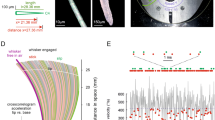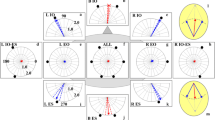Abstract
The angle of the coxa-trochanter (C-T) joint in the stick insect Carausius morosus is controlled by a negative feedback mechanism. It is shown that the trochanteral hair plate alone functions as the feedback transducer and that the rhomboid hair plate is not involved in the feedback loop.
The properties of the C-T control system were investigated by means of force measurements. The results cannot be adequately described in all details by either a fractional differentiator model, a model which fits many sensory systems, or a nonlinear bandpass filter, a model which fits the force response of the femur-tibia feedback loop. The fractional differentiator model adequately describes the frequency response of the open-loop system to sinusoidal stimulation with 34 deg stimulus amplitude. However, the responses to sinusoidal and steplike stimulation with 10 deg stimulus amplitude do not fit this model. They are better described by the model of a nonlinear bandpass filter.
The possible contribution of mechanical properties of the musculature and the joint to the total force response is discussed. It is suggested that cocontractions occurring at higher stimulus frequencies alters the muscle properties and enables the animal to respond to stimulus frequencies above the upper corner frequency of the active feedback loop.
Similar content being viewed by others
References
Bässler U (1972a) Der “Kniesehnenreflex” bei Carausius morosus: Übergangsfunktion und Frequenzgang. Kybernetik 11:32–50
Bässler U (1972b) Der Regelkreis des Kniesehnenreflexes bei der Stabheuschrecke Carausius morosus: Reaktionen auf passive Bewegungen der Tibia. Kybernetik 12:8–20
Bässler U (1983) Neural basis of elementary behavior in stick insects. Springer, New York Berlin Heidelberg
Bohnenberger J, Seyfarth EA, Barth FG (1983) A versatile feedback controller for electro-mechanical stimulation devices. J Neurosci Methods 9:335–341
Cruse H, Schmitz J (1983) The control system of the femur-tibia joint in the standing leg of a walking stick insect Carausius morosus. J Exp Biol 102:175–185
Cruse H, Storrer J (1977) Open loop analysis of a feedback mechanism controlling the leg position in the stick insect Carausius morosus: Comparison between experiment and simulation. Biol Cybern 25:143–153
Cruse H, Dean J, Suilmann M (1984) The contributions of diverse sense organs in the control of leg movement by a walking insect. J Comp Physiol 154:695–705
French AS, Kuster JE (1981) Sensory transduction in an insect mechanoreceptor: Extended bandwidth measurements and sensitivity to stimulus strength. Biol Cybern 42:87–94
French AS, Wong RKS (1976) The responses of trochanteral hairplate sensilla in the cockroach to periodic and random displacements. Biol Cybern 22:33–38
Godden DH (1974) The physiological mechanism of catalepsy in the stick insect Carausius morosus (Br). J Comp Physiol 89:251–274
Heukamp U (1983) Die Rolle von Mechanorezeptoren im Flugsystem der Wanderheuschrecke (Locusta migratoria L.): Übertragungseigenschaften und Analyse der Wirkung auf die Flugmotorik. Dissertation, Köln
Kemmerling S, Varju D (1981) Regulation of the body-substrate-distance in the stick insect: Responses to sinusoidal stimulation. Biol Cybern 39:129–137
Kemmerling S, Varju D (1982) Regulation of the body-substrate-distance in the stick insect: Step responses and modelling the control system. Biol Cybern 44:59–66
Kittmann R (1984) Quantitative Analyse von Verstärkungsänderungen eines Gelenkstellungsregelkreises. Dissertation, Kaiserslautern
Rack P (1981) Limitations of somatosensory feedback in control of posture and movement. In: Geiger R (ed) Handbook of physiology, vol II. American Physiological Society, Bethesda
Schmitz J (1985) Control of the leg joints in stick insects: Differences in the reflex properties between the standing and the walking states. In: Gewecke M, Wendler G (eds) Insect locomotion. Paul Parey, Hamburg, pp 27–32
Schmitz J (1986) The depressor trochanteris motoneurones and their role in the coxo-trochanteral feedback loop in the stick insect Carausius morosus. Biol Cybern 55:25–34
Storrer J, Cruse H (1977) Systemanalytische Untersuchung eines aufgeschnittenen Regelkreises, der die Beinstellung der Stabheuschrecke Carausius morosus kontrolliert: Kraftmessungen an den Antagonisten Flexor and Extensor tibiae. Biol Cybern 25:131–142
Tatar G (1976) Mechanische Sinnesorgane an den Beinen der Stabheuschrecke Carausius morosus. Diplomarbeit, Köln
Wendler G (1964) Laufen und Stehen der Stabheuschrecke Carausius morosus: Sinnesborstenfelder in den Beingelenken von Regelkreisen. Z Vergl Physiol 48:198–250
Wendler G (1972) Körperhaltung bei der Stabheuschrecke: Ihre Beziehung zur Schwereorientierung und Mechanismen ihrer Regelung. Verh Dtsch Zool Ges 65:214–219
Author information
Authors and Affiliations
Rights and permissions
About this article
Cite this article
Schmitz, J. Properties of the feedback system controlling the coxa-trochanter joint in the stick insect Carausius morosus . Biol. Cybern. 55, 35–42 (1986). https://doi.org/10.1007/BF00363976
Received:
Issue Date:
DOI: https://doi.org/10.1007/BF00363976




